
Michael H. (Harold) Brown (born March 5, 1952) is a Catholic author/journalist/speaker/and website owner in the United States. He has published 28 non-fiction books and two novels. He lives in Florida. In his days as a secular journalist, Mr. Brown was known mainly for his role in exposing the Love Canal toxic waste crisis in his hometown of Niagara Falls, for  which he was nominated for three Pulitzer prizes. He was named in 1984 as one of People Magazine’s “people of the first decade” [1]. He also wrote books about the Mafia, parapsychology, air contamination, and use of DNA to track the origin of modern humans. The Love Canal created many controversies, and executives of the Hooker Chemical Company, which has since changed its name, took to national airwaves and massive mailings to rebut him. He later became known for his Christian-Catholic books. His work appeared in publications such as The Atlantic Monthly, The New York Times Magazine, Reader’s Digest, Science Digest, Discover, New York, Saturday Review, Rolling Stone, and others. He spoke for ten years on the college lecture circuit on toxic contamination, spurring the creation of many local activist groups in the 1980s and appearing on many television and radio shows. A cover story in the Atlantic won that year’s Sidney Hillman Award. He considered the contamination of nature neither a liberal or conservative issue, but a human and spiritual one. Since 1991, he has written almost exclusively on spiritual topics, including Christian bestselling The Final Hour, Witness, and The Other Side. [For spiritual/Catholic bio, scroll down] [For recent Niagara Gazette article, see here]
which he was nominated for three Pulitzer prizes. He was named in 1984 as one of People Magazine’s “people of the first decade” [1]. He also wrote books about the Mafia, parapsychology, air contamination, and use of DNA to track the origin of modern humans. The Love Canal created many controversies, and executives of the Hooker Chemical Company, which has since changed its name, took to national airwaves and massive mailings to rebut him. He later became known for his Christian-Catholic books. His work appeared in publications such as The Atlantic Monthly, The New York Times Magazine, Reader’s Digest, Science Digest, Discover, New York, Saturday Review, Rolling Stone, and others. He spoke for ten years on the college lecture circuit on toxic contamination, spurring the creation of many local activist groups in the 1980s and appearing on many television and radio shows. A cover story in the Atlantic won that year’s Sidney Hillman Award. He considered the contamination of nature neither a liberal or conservative issue, but a human and spiritual one. Since 1991, he has written almost exclusively on spiritual topics, including Christian bestselling The Final Hour, Witness, and The Other Side. [For spiritual/Catholic bio, scroll down] [For recent Niagara Gazette article, see here]
 which he was nominated for three Pulitzer prizes. He was named in 1984 as one of People Magazine’s “people of the first decade” [1]. He also wrote books about the Mafia, parapsychology, air contamination, and use of DNA to track the origin of modern humans. The Love Canal created many controversies, and executives of the Hooker Chemical Company, which has since changed its name, took to national airwaves and massive mailings to rebut him. He later became known for his Christian-Catholic books. His work appeared in publications such as The Atlantic Monthly, The New York Times Magazine, Reader’s Digest, Science Digest, Discover, New York, Saturday Review, Rolling Stone, and others. He spoke for ten years on the college lecture circuit on toxic contamination, spurring the creation of many local activist groups in the 1980s and appearing on many television and radio shows. A cover story in the Atlantic won that year’s Sidney Hillman Award. He considered the contamination of nature neither a liberal or conservative issue, but a human and spiritual one. Since 1991, he has written almost exclusively on spiritual topics, including Christian bestselling The Final Hour, Witness, and The Other Side. [For spiritual/Catholic bio, scroll down] [For recent Niagara Gazette article, see here]
which he was nominated for three Pulitzer prizes. He was named in 1984 as one of People Magazine’s “people of the first decade” [1]. He also wrote books about the Mafia, parapsychology, air contamination, and use of DNA to track the origin of modern humans. The Love Canal created many controversies, and executives of the Hooker Chemical Company, which has since changed its name, took to national airwaves and massive mailings to rebut him. He later became known for his Christian-Catholic books. His work appeared in publications such as The Atlantic Monthly, The New York Times Magazine, Reader’s Digest, Science Digest, Discover, New York, Saturday Review, Rolling Stone, and others. He spoke for ten years on the college lecture circuit on toxic contamination, spurring the creation of many local activist groups in the 1980s and appearing on many television and radio shows. A cover story in the Atlantic won that year’s Sidney Hillman Award. He considered the contamination of nature neither a liberal or conservative issue, but a human and spiritual one. Since 1991, he has written almost exclusively on spiritual topics, including Christian bestselling The Final Hour, Witness, and The Other Side. [For spiritual/Catholic bio, scroll down] [For recent Niagara Gazette article, see here]+
EARLY LIFE (secular)
+
 Michael H. Brown was born at Mount Saint Mary Hospital near Niagara Falls, where he attended public schools through high school. He had seven siblings, including a twin sister, Maureen. He is the son of Harold, a CPA, and Rose, a public school teacher. Both were lifelong and faithful Catholics, his father an altar boy. During his childhood Brown suffered acute asthma, which he told his parents was from the smokestacks spewing contaminants in the city. (Factory odors sometimes could be smelled at his home.) During summers, he worked construction. Brown
Michael H. Brown was born at Mount Saint Mary Hospital near Niagara Falls, where he attended public schools through high school. He had seven siblings, including a twin sister, Maureen. He is the son of Harold, a CPA, and Rose, a public school teacher. Both were lifelong and faithful Catholics, his father an altar boy. During his childhood Brown suffered acute asthma, which he told his parents was from the smokestacks spewing contaminants in the city. (Factory odors sometimes could be smelled at his home.) During summers, he worked construction. Brown 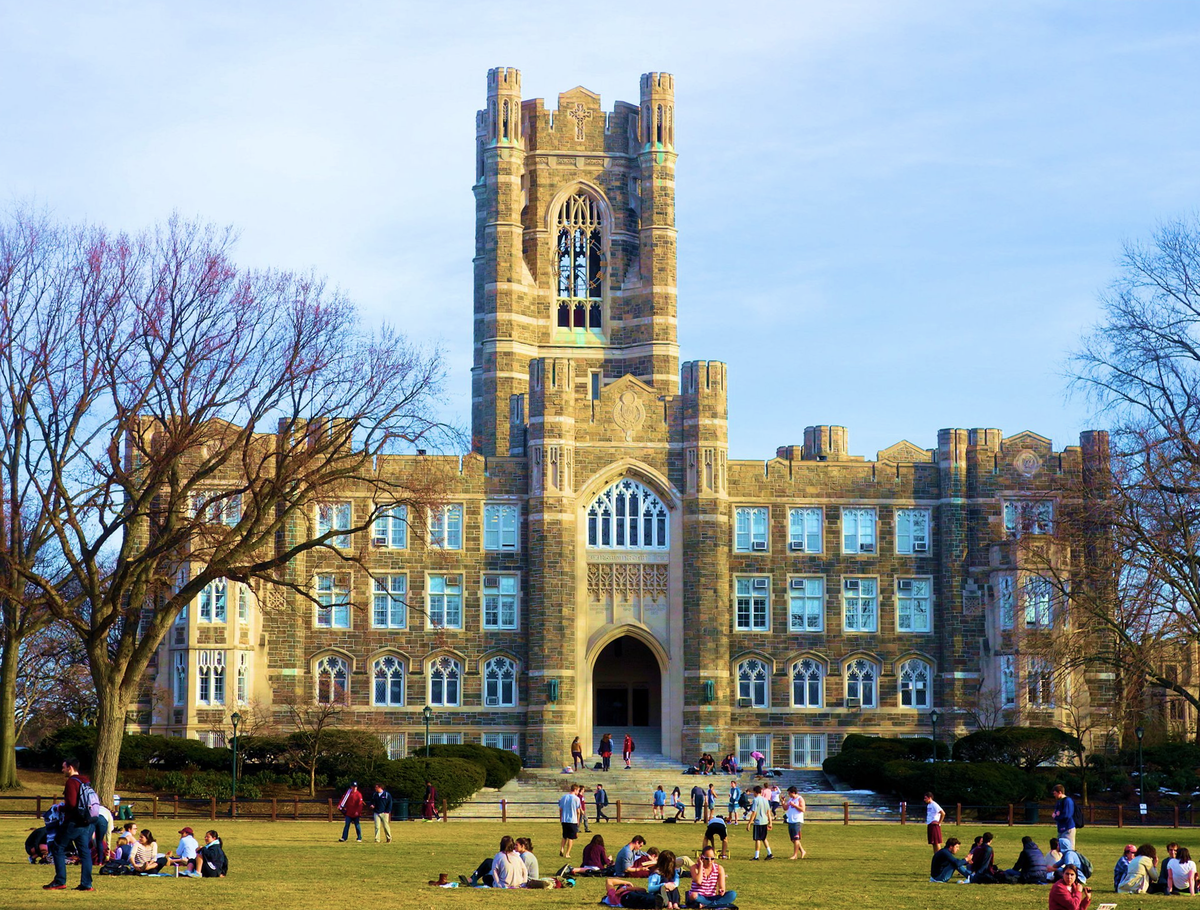 attended Fordham University in The Bronx, New York, a Jesuit school where he worked on the school newspaper, The Ram, eventually as features editor and majored in communication with a specialty of print journalism. Upon graduation he was hired as a general assignment reporter for the Binghamton (N.Y.) Sun-Bulletin, where on April 7, 1975, he wrote what was the longest article in that newspaper’s 153-year history, focusing on a school teacher named Phil Jordan who was forced from the school system in Spencer, New York, because of his “psychic” demonstrations, including the apparently paranormal ability to clairvoyantly find objects and cause psychokinetic (mind-over-matter) effects [2]. Brown had Jordan examined by magicians, a hypnotist, and fellow reporters, and took Mr. Jordan to the Kent State University’s Smith Hall of Physics, under the purview of renowned physicist, Dr. Wilbur Franklin, who was unable to explain how Jordan was causing apparently psychokinetic effects. Michael Brown left the newspaper in the summer of 1975 after a dispute with the managing editor and began work on a book about psychokinesis, though he later came to believe such abilities were occult and to be avoided. He now speaks and writes about the spiritual dangers. The book, PK: A Report on Psychokinesis, was published by Steinerbooks in New York in 1976. His first radio show turned out to be his longest: a five-hour all-night appearance with then-legendary New York broadcaster “Long John” Nebel and his wife, Candy Jones on WMCA in Manhattan. Dr. J. B. Rhine of Duke University (who coined the terms ESP and PK) wrote a letter lauding an article of Brown’s in the Atlantic that dealt with this controversial area.
attended Fordham University in The Bronx, New York, a Jesuit school where he worked on the school newspaper, The Ram, eventually as features editor and majored in communication with a specialty of print journalism. Upon graduation he was hired as a general assignment reporter for the Binghamton (N.Y.) Sun-Bulletin, where on April 7, 1975, he wrote what was the longest article in that newspaper’s 153-year history, focusing on a school teacher named Phil Jordan who was forced from the school system in Spencer, New York, because of his “psychic” demonstrations, including the apparently paranormal ability to clairvoyantly find objects and cause psychokinetic (mind-over-matter) effects [2]. Brown had Jordan examined by magicians, a hypnotist, and fellow reporters, and took Mr. Jordan to the Kent State University’s Smith Hall of Physics, under the purview of renowned physicist, Dr. Wilbur Franklin, who was unable to explain how Jordan was causing apparently psychokinetic effects. Michael Brown left the newspaper in the summer of 1975 after a dispute with the managing editor and began work on a book about psychokinesis, though he later came to believe such abilities were occult and to be avoided. He now speaks and writes about the spiritual dangers. The book, PK: A Report on Psychokinesis, was published by Steinerbooks in New York in 1976. His first radio show turned out to be his longest: a five-hour all-night appearance with then-legendary New York broadcaster “Long John” Nebel and his wife, Candy Jones on WMCA in Manhattan. Dr. J. B. Rhine of Duke University (who coined the terms ESP and PK) wrote a letter lauding an article of Brown’s in the Atlantic that dealt with this controversial area.+
LOVE CANAL
+
In January, 1977, Brown went back to newspaper work at the Niagara Gazette. One of his first assignments was covering the Great Blizzard of 1977. At first a reporter covering the small towns of Lewiston and Porter, he became intrigued by an issue of which he had never heard: toxic chemical waste disposal. This arose due to the existence in those towns of a company called Chem-Trol (later SCA) that was bringing in the most toxic compounds from around the nation and burying them in “secure landfills” in a wooded area near Lake Ontario, upsetting largely rural residents who feared they would leak, including a councilwoman named Joan Gipp whom Brown credits with sparking the toxic-waste awareness in Western New York.
+
 Brown wrote extensively about the company and its potential threat to the waterways throughout 1977, at one point listening at a public hearing in the Town of Porter as a young woman tearfully described her family’s torment due to a chemical dump in Niagara Falls known as “Love Canal,” which Mr. Brown knew little or nothing about. He also wrote of a federal nuclear site, the Lake Ontario Ordnance Works, where highly radioactive wastes from the production of uranium yellowcake for the Manhattan Project was stored in a cement silo was emitting radon gas and suspected of sickening those nearby. (The silo was eventually removed and radioactive substances relocated or secured there, after Brown joined forces with New York Times reporter Donald G. McNeil, who also wrote about it. McNeil has since become well-known for his prescient coverage of Covid-19.
Brown wrote extensively about the company and its potential threat to the waterways throughout 1977, at one point listening at a public hearing in the Town of Porter as a young woman tearfully described her family’s torment due to a chemical dump in Niagara Falls known as “Love Canal,” which Mr. Brown knew little or nothing about. He also wrote of a federal nuclear site, the Lake Ontario Ordnance Works, where highly radioactive wastes from the production of uranium yellowcake for the Manhattan Project was stored in a cement silo was emitting radon gas and suspected of sickening those nearby. (The silo was eventually removed and radioactive substances relocated or secured there, after Brown joined forces with New York Times reporter Donald G. McNeil, who also wrote about it. McNeil has since become well-known for his prescient coverage of Covid-19.+
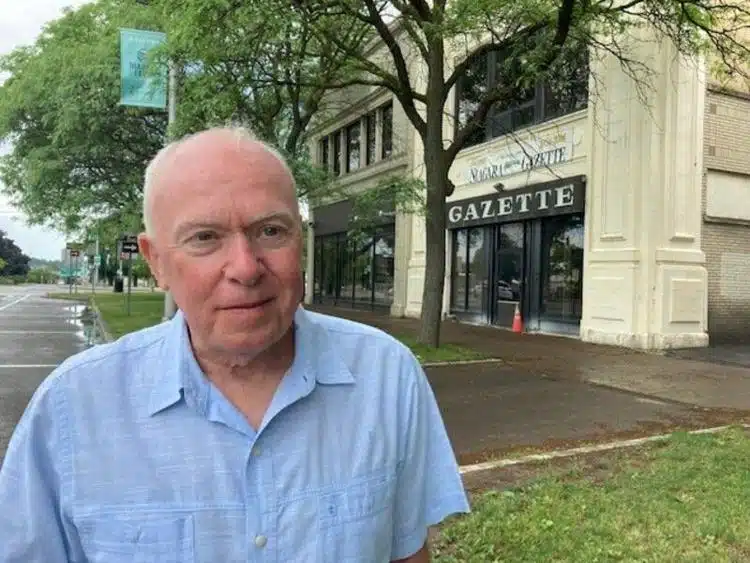 Brown once more ran across Love Canal when assigned in the summer of 1977 by city editor David Pollak to cover a meeting in Buffalo between the city, the Niagara County Health Department, and an engineering firm, Cal-Span of Buffalo, concerning effluents from that dump, once used (1947-1953) by the Hooker Chemical Company (once Hooker Chemicals and Plastics). Rainwater was carrying chemicals from the canal — an old hydroelectric channel built by an entrepreneur named William Love that was never used as such — into the sump pumps of homes that now abutted it at the southern ends of 97th and 99th Streets in Niagara Falls. The leaking was first reported, in 1976, by Pollak and another reporter, David Russell, who had sump-pump water analyzed. Problems had been noticed since 1959. Though not established as a health threat, the city was embarking, with Cal-Span, on a project to halt the pollution in a small area at the southernmost end. At the meeting Brown attended, he met a consultant whom he asked about the seriousness of the situation, which was not at the time a significant local issue and had been out of the news. On an elevator ride down, the engineer shrugged when asked by Brown if it was a health threat, saying that no one yet knew. Asked if there was a chance it could harm people, the engineer told Michael Brown that “someone’s going to have to dig in there and take a good look. If they don’t, your child or children’s children are going to run into problems.” Recalling the tearful woman at the Chem-Trol meeting, Brown immediately began looking at the Love Canal situation closely [3] and in weekly columns urging city action [4] [5] on Love Canal.
Brown once more ran across Love Canal when assigned in the summer of 1977 by city editor David Pollak to cover a meeting in Buffalo between the city, the Niagara County Health Department, and an engineering firm, Cal-Span of Buffalo, concerning effluents from that dump, once used (1947-1953) by the Hooker Chemical Company (once Hooker Chemicals and Plastics). Rainwater was carrying chemicals from the canal — an old hydroelectric channel built by an entrepreneur named William Love that was never used as such — into the sump pumps of homes that now abutted it at the southern ends of 97th and 99th Streets in Niagara Falls. The leaking was first reported, in 1976, by Pollak and another reporter, David Russell, who had sump-pump water analyzed. Problems had been noticed since 1959. Though not established as a health threat, the city was embarking, with Cal-Span, on a project to halt the pollution in a small area at the southernmost end. At the meeting Brown attended, he met a consultant whom he asked about the seriousness of the situation, which was not at the time a significant local issue and had been out of the news. On an elevator ride down, the engineer shrugged when asked by Brown if it was a health threat, saying that no one yet knew. Asked if there was a chance it could harm people, the engineer told Michael Brown that “someone’s going to have to dig in there and take a good look. If they don’t, your child or children’s children are going to run into problems.” Recalling the tearful woman at the Chem-Trol meeting, Brown immediately began looking at the Love Canal situation closely [3] and in weekly columns urging city action [4] [5] on Love Canal.+
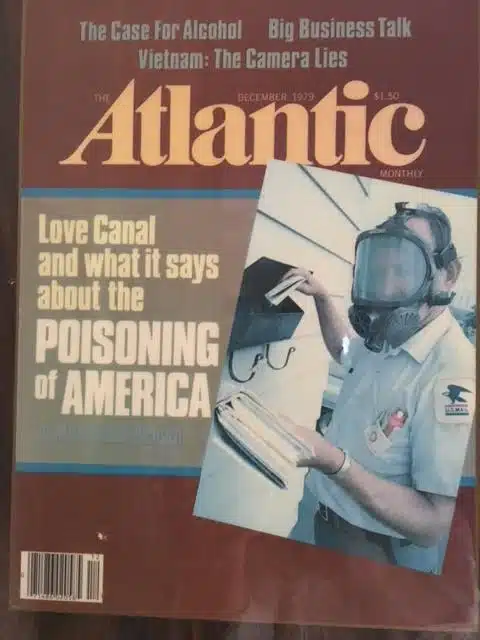 Assured by the county health department and its commissioner, Dr. Francis Clifford, that Love Canal was not a health risk [6], Brown nevertheless began making regular phone calls inquiring as to the status of remedial action, often met with stonewalling. The city was planning a remedial drainage program, he was assured, though it was caught in governmental-corporate haggling and red tape over Love Canal. Thus far the remedy was to install two basement window fans in the two most afflicted houses. At the time, the Hooker Company was the largest employer in the area, with three thousand of employees and thousands elsewhere in more than a dozen countries. It was closely tied to local politicians and now owned by Occidental Petroleum and headquartered in Houston, Texas, and Los Angeles, California.
Assured by the county health department and its commissioner, Dr. Francis Clifford, that Love Canal was not a health risk [6], Brown nevertheless began making regular phone calls inquiring as to the status of remedial action, often met with stonewalling. The city was planning a remedial drainage program, he was assured, though it was caught in governmental-corporate haggling and red tape over Love Canal. Thus far the remedy was to install two basement window fans in the two most afflicted houses. At the time, the Hooker Company was the largest employer in the area, with three thousand of employees and thousands elsewhere in more than a dozen countries. It was closely tied to local politicians and now owned by Occidental Petroleum and headquartered in Houston, Texas, and Los Angeles, California.+
During the spring of 1978, Brown began wondering if the chemicals tracked in sump pumps might already be causing health effects after learning that benzene — at the time the only definitively proven chemical carcinogen — had been tracked in the air of several homes, which made it much more of a potential health threat than simply sump-pump contamination [7]. Brown set about meeting with Love Canal residents, especially Timothy and Karen Schroeder, and Karen’s parents, the Voorhees, who lived at the southern end of 99th Street, where he was to learn that chemicals that had been forced out of their confinement (in large part due to the blizzard in 1977) were occasionally swamping several backyards during heavy rain or snow melt and even had pushed a swimming pool out of the ground and oozed as black sludge through the drain of another across the way on 97th Street, where Brown discovered that a woman who lived there, Rosalee Janese, had unusually severe skin problems and other ailments — symptoms that Brown soon found were identical to those caused by dioxin (a serious skin disorder, “cloracne”, that involved more than just the skin). For their part the Schroeders had a daughter named Sheri who had more than a dozen birth defects, including a cleft palate, irregular heart beat, hole in her heart, learning disabilities, and double row of bottom teeth[8].
+
 Michael Brown set about a door-to-door anecdotal health survey of south 99th and 97th streets, finding a shocking number of health complaints, from miscarriages and birth defects to respiratory problems, seizures, and cancers. Love Canal was not merely an environmental issue, he decided, but a serious health threat. In May also he came across a memo from the Environmental Protection Agency office in Rochester stating that tests already conducted by the state suggested “a serious threat to health and welfare.” [9] Though no one knew, at the time, aside from Hooker, what precisely was in the canal, the effluents went beyond solvents like benzene and trichlorethylene and included highly toxic chlorinated hydrocarbons used for pesticides, herbicides, and plastics, including C-56 (a building block for the now-banned pesticide Mirex) and other compounds similar to DDT.
Michael Brown set about a door-to-door anecdotal health survey of south 99th and 97th streets, finding a shocking number of health complaints, from miscarriages and birth defects to respiratory problems, seizures, and cancers. Love Canal was not merely an environmental issue, he decided, but a serious health threat. In May also he came across a memo from the Environmental Protection Agency office in Rochester stating that tests already conducted by the state suggested “a serious threat to health and welfare.” [9] Though no one knew, at the time, aside from Hooker, what precisely was in the canal, the effluents went beyond solvents like benzene and trichlorethylene and included highly toxic chlorinated hydrocarbons used for pesticides, herbicides, and plastics, including C-56 (a building block for the now-banned pesticide Mirex) and other compounds similar to DDT.+
There turned out to be hundreds of chemicals, including TCP, or 2,4,6-trichlorophenol, which Brown learned virtually always carried, as an unwanted byproduct, tetra-chloro-dibenzo-para-dioxin, TCDD or “dioxin” for short. The burial of trichlorophenol at Love Canal was proven later in 1978 when a source from a remedial chemical company called Brown to inform him and Hooker confirmed it. Soon, dioxin itself was detected. The resultant news stunned officials and the nation. In June a former city bulldozer operator also had called Brown to tell him he had once seen the U.S. Army bury several metal drums there, raising the possibility of radioactivity, though this was never confirmed, nor did Brown pick up radioactivity at Love Canal on a Geiger counter he purchased. He suggested to the Schroeders that they form a citizens’ group and petition the city, which they did. Besides the window fans, all that had been done was erection of a snow fence to keep people off the dump’s deteriorating surface. Dr. Clifford phoned Brown angrily. “When are you going to go back to being a reporter?” he barked. Michael H. Brown also met great resistance from two other doctors, Dr. Mitchell Zavon, who was employed by Hooker, and a local dermatologist who blasted the reporter for suggesting that Janese had chloracne (which the doctor was not familiar with, having diagnosed her as having lupus). A state senator called Brown in an attempt to halt his reporting on the situation, lest he “panic” people.
+
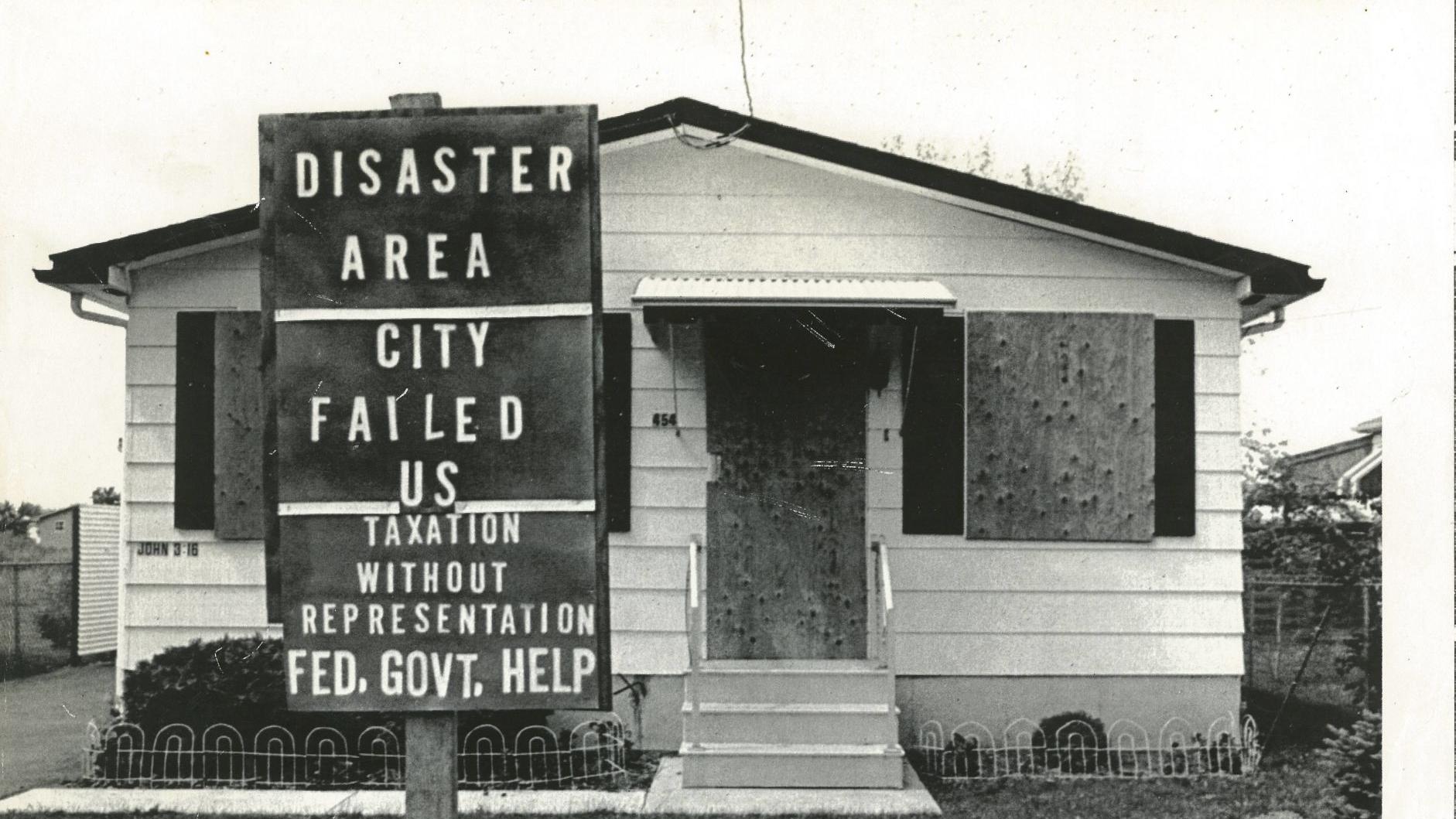 During May of 1978, Mr. Brown had informed the New York State Health Department of his door-to-door survey, which the managing editor chose not to print in full because it was not an official study. Still, the indications of possible birth defects and other ailments made their way into the Gazette’s coverage. After receiving Michael’s phone call, the state health department immediately announced it would be conducting an official medical investigation, which may have been in the discussion stage [9]. On July 14 Brown learned that a preliminary survey by the state of Love Canal indicated possible birth defects [11]. In the more formal study, state epidemiologist Dr. Nicolas Vianni very quickly determined through survey questionnaires and blood tests that there indeed seemed to be an abnormal prevalence of miscarriages and birth defects alongside Love Canal, along with unusual liver enzyme levels. This soon caused the state health commissioner, Dr. Joseph Whalen, to declare an unprecedented health emergency. It was the first such emergency in American history. Brown collected sump-pump samples from a neighborhood a mile from the worst-hit section and had it analyzed, along with logging state air sample results.[12]
During May of 1978, Mr. Brown had informed the New York State Health Department of his door-to-door survey, which the managing editor chose not to print in full because it was not an official study. Still, the indications of possible birth defects and other ailments made their way into the Gazette’s coverage. After receiving Michael’s phone call, the state health department immediately announced it would be conducting an official medical investigation, which may have been in the discussion stage [9]. On July 14 Brown learned that a preliminary survey by the state of Love Canal indicated possible birth defects [11]. In the more formal study, state epidemiologist Dr. Nicolas Vianni very quickly determined through survey questionnaires and blood tests that there indeed seemed to be an abnormal prevalence of miscarriages and birth defects alongside Love Canal, along with unusual liver enzyme levels. This soon caused the state health commissioner, Dr. Joseph Whalen, to declare an unprecedented health emergency. It was the first such emergency in American history. Brown collected sump-pump samples from a neighborhood a mile from the worst-hit section and had it analyzed, along with logging state air sample results.[12]+
 The declaration was made on August 2, 1978 [13], and led to massive national publicity, including on The New York Times front page and all three news networks (NBC, CBS, and ABC). Angry residents filled the streets, demanding evacuation, which soon was to come for 237 households. President Jimmy Carter also declared an emergency. The Times had the reporter, Donald G. McNeil, in Niagara Falls. He had been briefed on the situation by Brown, shown the situation, and handed a box of documents and notes Mr. Brown had gathered, facilitating national and soon international coverage. Shortly before the declaration, Brown also had received a visit from a woman, Lois Gibbs, who lived several blocks from the canal but was concerned about what she was reading. He gave her copies of Gazette articles about Love Canal and the Cal-Span report. Along with two other residents, she soon formed a formal homeowners association and working full-time and tirelessly, helped keep the matter before the local media, especially Buffalo television stations, with public demonstrations after the August 2 declaration. The results of the samples from other sump pumps to the north of the Schroeders were given to Brown by a private chemical company that wanted anonymity on August 4 and showed the dump was three times the size officials said and a threat to many hundreds more.
The declaration was made on August 2, 1978 [13], and led to massive national publicity, including on The New York Times front page and all three news networks (NBC, CBS, and ABC). Angry residents filled the streets, demanding evacuation, which soon was to come for 237 households. President Jimmy Carter also declared an emergency. The Times had the reporter, Donald G. McNeil, in Niagara Falls. He had been briefed on the situation by Brown, shown the situation, and handed a box of documents and notes Mr. Brown had gathered, facilitating national and soon international coverage. Shortly before the declaration, Brown also had received a visit from a woman, Lois Gibbs, who lived several blocks from the canal but was concerned about what she was reading. He gave her copies of Gazette articles about Love Canal and the Cal-Span report. Along with two other residents, she soon formed a formal homeowners association and working full-time and tirelessly, helped keep the matter before the local media, especially Buffalo television stations, with public demonstrations after the August 2 declaration. The results of the samples from other sump pumps to the north of the Schroeders were given to Brown by a private chemical company that wanted anonymity on August 4 and showed the dump was three times the size officials said and a threat to many hundreds more.+
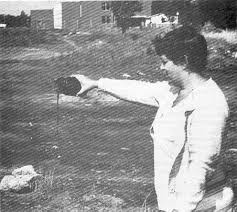 Brown soon learned that the potential health threat went beyond the first two “rings” of home at Love Canal, with indications of other illnesses far away from the Schroeders along old swales and creekbeds that were suspected of carrying toxicants[14] [15]. Further testing by Brown, and then the state, as well as air samples, buttressed this possibility, and the evacuation zones at Love Canal were expanded, soon including hundreds of more homes in 1978. Memos he obtained from state sources showed contamination (in old creek beds,) as far as 101st Street. Brown continued to report further health effects. It was in November that the existence of dioxin in the canal — in seepage — was discovered when on December 9 he received a confidential (but later revealed) call from Dr. David Axelrod, chief of the state Health Department’s laboratory and soon to be health commissioner. Hooker was increasingly upset with Brown, whom they had first called to a meeting the day before the watershed August 1 declaration in an effort to downplay it. Mr. Brown had serious clashes with Hooker executive vice president as well as the corporation’s public relations executive. He also had tense moments with his publisher, who was being pressured by Hooker. Mr. Brown’s confrontations with Hooker even were mentioned in The New York Times. Including smaller news items and articles, Brown wrote about a hundred articles on Love Canal.
Brown soon learned that the potential health threat went beyond the first two “rings” of home at Love Canal, with indications of other illnesses far away from the Schroeders along old swales and creekbeds that were suspected of carrying toxicants[14] [15]. Further testing by Brown, and then the state, as well as air samples, buttressed this possibility, and the evacuation zones at Love Canal were expanded, soon including hundreds of more homes in 1978. Memos he obtained from state sources showed contamination (in old creek beds,) as far as 101st Street. Brown continued to report further health effects. It was in November that the existence of dioxin in the canal — in seepage — was discovered when on December 9 he received a confidential (but later revealed) call from Dr. David Axelrod, chief of the state Health Department’s laboratory and soon to be health commissioner. Hooker was increasingly upset with Brown, whom they had first called to a meeting the day before the watershed August 1 declaration in an effort to downplay it. Mr. Brown had serious clashes with Hooker executive vice president as well as the corporation’s public relations executive. He also had tense moments with his publisher, who was being pressured by Hooker. Mr. Brown’s confrontations with Hooker even were mentioned in The New York Times. Including smaller news items and articles, Brown wrote about a hundred articles on Love Canal.+
Michael Brown’s investigation continued through 1978 and early 1979. In 1978, it had expanded to other, potentially even more dangerous dumps, including a Hooker dump called the 101 Street landfill [16]; a third called the “S-Area” on Hooker’s property [17]; and a fourth called the Hyde Park landfill (or “Bloody Run,” after the name of a creek that flowed from it). Brown learned in a call from two scuba divers hired by the city to do periodic checks of its water-plant intake pipes in the Niagara River, ju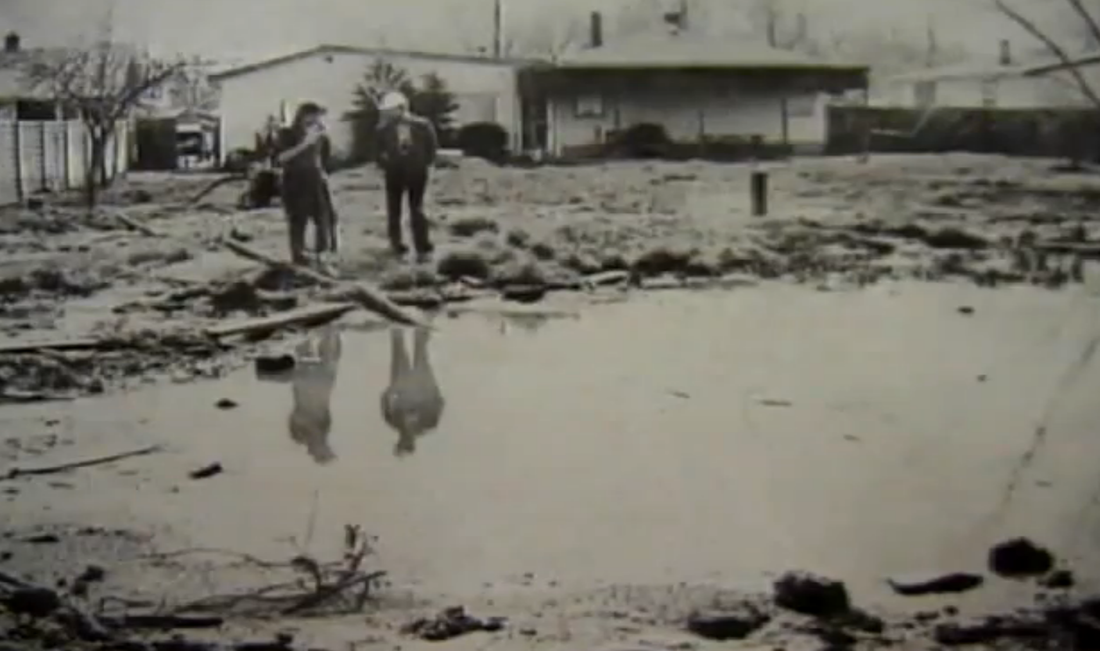 st above the famous falls, that there was a chemical odor to sludge they found in the pipe. Brown was to discover that it came from the “S-Area” dump, which was immediately adjacent to the water plant (which supplied the entire city) and was larger than Love Canal, with the same chemicals. The water plant eventually had to be completely relocated. He also found tremendous contamination in Gill Creek just above the cataracts, his hand burning as he reached into the black sediment with a jar. An analysis showed it to have the highest level of PCBs ever detected in an open environment. This time the culprit was DuPont, which quickly took the blame and set about dredging the channel at a cost of $1.2 million (vastly less than Hooker would end paying for its much larger situations).[18]
st above the famous falls, that there was a chemical odor to sludge they found in the pipe. Brown was to discover that it came from the “S-Area” dump, which was immediately adjacent to the water plant (which supplied the entire city) and was larger than Love Canal, with the same chemicals. The water plant eventually had to be completely relocated. He also found tremendous contamination in Gill Creek just above the cataracts, his hand burning as he reached into the black sediment with a jar. An analysis showed it to have the highest level of PCBs ever detected in an open environment. This time the culprit was DuPont, which quickly took the blame and set about dredging the channel at a cost of $1.2 million (vastly less than Hooker would end paying for its much larger situations).[18]
 st above the famous falls, that there was a chemical odor to sludge they found in the pipe. Brown was to discover that it came from the “S-Area” dump, which was immediately adjacent to the water plant (which supplied the entire city) and was larger than Love Canal, with the same chemicals. The water plant eventually had to be completely relocated. He also found tremendous contamination in Gill Creek just above the cataracts, his hand burning as he reached into the black sediment with a jar. An analysis showed it to have the highest level of PCBs ever detected in an open environment. This time the culprit was DuPont, which quickly took the blame and set about dredging the channel at a cost of $1.2 million (vastly less than Hooker would end paying for its much larger situations).[18]
st above the famous falls, that there was a chemical odor to sludge they found in the pipe. Brown was to discover that it came from the “S-Area” dump, which was immediately adjacent to the water plant (which supplied the entire city) and was larger than Love Canal, with the same chemicals. The water plant eventually had to be completely relocated. He also found tremendous contamination in Gill Creek just above the cataracts, his hand burning as he reached into the black sediment with a jar. An analysis showed it to have the highest level of PCBs ever detected in an open environment. This time the culprit was DuPont, which quickly took the blame and set about dredging the channel at a cost of $1.2 million (vastly less than Hooker would end paying for its much larger situations).[18]+
Brown’s investigation of the firm’s Hyde Park landfill — which was several times the volume of Love Canal, again with the same compounds — began with a call from a concerned citizen, Fred Armagost, along Bloody Run Creek. Brown  had the sediment tested, surveyed the area in a small airplane, and began intensive reportage when the tests he had sent for analysis turned up chemicals similar to Love Canal — leading to another uproar and several dozen evacuated homes. Brown discovered that Mirex was leaking from the landfill into the great freshwater body of water, Lake Ontario. For years, fishing of certain species had been banned or restricted in that great lake due to Mirex contamination, though no one knew where it originated. Hooker was now seen as the culprit. Then-congressman Al Gore visited the creek, which was upstream from the city of Toronto. Soon, the state moved in with testing that discovered dioxin. This dump was the largest environmental threat in Niagara Falls and perhaps the nation. Hooker was sued by both the state and U.S. attorneys general for its dumps and had to pay many hundreds of millions if not billions of dollars (in today’s value) in remedial measures and private lawsuits.
had the sediment tested, surveyed the area in a small airplane, and began intensive reportage when the tests he had sent for analysis turned up chemicals similar to Love Canal — leading to another uproar and several dozen evacuated homes. Brown discovered that Mirex was leaking from the landfill into the great freshwater body of water, Lake Ontario. For years, fishing of certain species had been banned or restricted in that great lake due to Mirex contamination, though no one knew where it originated. Hooker was now seen as the culprit. Then-congressman Al Gore visited the creek, which was upstream from the city of Toronto. Soon, the state moved in with testing that discovered dioxin. This dump was the largest environmental threat in Niagara Falls and perhaps the nation. Hooker was sued by both the state and U.S. attorneys general for its dumps and had to pay many hundreds of millions if not billions of dollars (in today’s value) in remedial measures and private lawsuits.
 had the sediment tested, surveyed the area in a small airplane, and began intensive reportage when the tests he had sent for analysis turned up chemicals similar to Love Canal — leading to another uproar and several dozen evacuated homes. Brown discovered that Mirex was leaking from the landfill into the great freshwater body of water, Lake Ontario. For years, fishing of certain species had been banned or restricted in that great lake due to Mirex contamination, though no one knew where it originated. Hooker was now seen as the culprit. Then-congressman Al Gore visited the creek, which was upstream from the city of Toronto. Soon, the state moved in with testing that discovered dioxin. This dump was the largest environmental threat in Niagara Falls and perhaps the nation. Hooker was sued by both the state and U.S. attorneys general for its dumps and had to pay many hundreds of millions if not billions of dollars (in today’s value) in remedial measures and private lawsuits.
had the sediment tested, surveyed the area in a small airplane, and began intensive reportage when the tests he had sent for analysis turned up chemicals similar to Love Canal — leading to another uproar and several dozen evacuated homes. Brown discovered that Mirex was leaking from the landfill into the great freshwater body of water, Lake Ontario. For years, fishing of certain species had been banned or restricted in that great lake due to Mirex contamination, though no one knew where it originated. Hooker was now seen as the culprit. Then-congressman Al Gore visited the creek, which was upstream from the city of Toronto. Soon, the state moved in with testing that discovered dioxin. This dump was the largest environmental threat in Niagara Falls and perhaps the nation. Hooker was sued by both the state and U.S. attorneys general for its dumps and had to pay many hundreds of millions if not billions of dollars (in today’s value) in remedial measures and private lawsuits.+
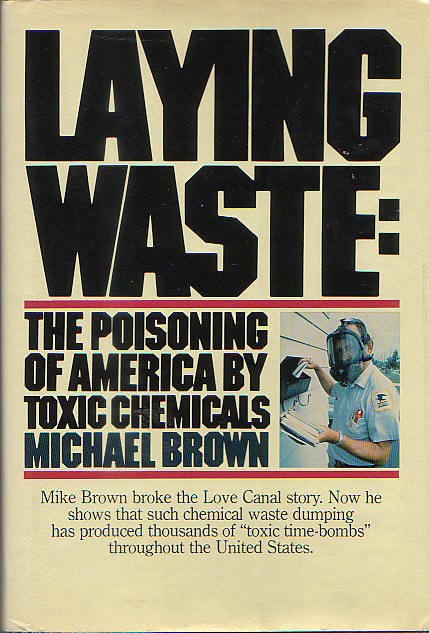 Michael H. Brown wrote about these investigations — and expanded his investigation nationwide — in a book released at the end of 1979 called Laying Waste: The Poisoning of America by Toxic Chemicals [19], which was published by the Pantheon division of Random House and drew publicity around the nation and exposed more dumps. The Hooker Company threatened Random House over the book, hiring famed libel attorney Louis Nizer (by this time it had more than thirty attorneys working its toxic cases). Brown, 27, had left the Niagara Gazette under tense circumstances to pursue the book after writing a major article for The New York Times Magazine, “Love Canal, USA,” that was published on January 21, 1979 [20], the first major story surveying the situation nationwide. This article had obvious influence in New York and Washington.
Michael H. Brown wrote about these investigations — and expanded his investigation nationwide — in a book released at the end of 1979 called Laying Waste: The Poisoning of America by Toxic Chemicals [19], which was published by the Pantheon division of Random House and drew publicity around the nation and exposed more dumps. The Hooker Company threatened Random House over the book, hiring famed libel attorney Louis Nizer (by this time it had more than thirty attorneys working its toxic cases). Brown, 27, had left the Niagara Gazette under tense circumstances to pursue the book after writing a major article for The New York Times Magazine, “Love Canal, USA,” that was published on January 21, 1979 [20], the first major story surveying the situation nationwide. This article had obvious influence in New York and Washington.+
Mr. Brown moved to Manhattan just before release of the book, which received a full-page review in the prestigious New York Times Book Review, among many dozens of other newspapers. Michael appeared on hundreds of radio and TV shows, including national ones such as Today, Nightline, and McNeil-Lehrer. The book was excerpted or adapted in the Atlantic Monthly (cover story) [21], The New York Times Magazine (three times [22][23]), Reader’s Digest[22] [23], New York [24], Family Weekly [25], and other publications. The issue of toxic chemical wastes had been established.
+
The situation was not without intrigues. At various points Michael saw suspicious cars following him during return trips to Niagara Falls, and so concerned was Pocketbooks, which published the paperback of Laying Waste, that at one point it wanted to hire a security guard for Brown’s hotel room during publicity appearances in the oil-hotbed of Houston (an offer he declined). There were indications that a chemical company had surreptitiously obtained his schedule of media appearances, with an executive barging into one television studio in Chicago. During a trip to Niagara Falls to attend a wedding, the journalist was arrested and roughed up for no reason by two police officers and thrown in jail overnight. (One of the officers was related to the mayor. Charges were entirely dropped and expunged from the record days later after a Buffalo attorney, Barbara Morrison, intervened pro bono, threatening to sue the city. The mayor, Michael O’Laughlin, would later blurt “Over my dead body!” when a councilman proposed a “Michael Brown Day” for exposing the imminent health threat at Love Canal.) Brown also debated Hooker executives on shows such as Today. Pantheon took out a special ad in The New York Times when a dump in New Jersey owned by a Mafia associate, and cited in Laying Waste as ready to explode, did just that, its smoke threatening lower Manhattan soon after the book’s release. People photographed Mr. Brown at that facility after the event. Legendary Watergate reported Bob Woodward once took out the book during a dinner party at his home and showed it to reporter Loretta Tofani, herself a Pulitzer-Prize winner, as an example of investigative reportage. Mr. Brown and his newspaper were denied the Pulitzer Prize in public service for 1978 when, just before the decision, the massacre in Guyana of Jim Jones cult followers erupted, dominating the news and eclipsing Love Canal. (The local newspaper there won the Pulitzer, with the Niagara Gazette reportedly second). Mr. Brown did receive a special award from the U.S. Environmental Agency and won the Sidney Hillman Award for best magazine story (the Atlantic Monthly serialization). His book was endorsed by Jessica Mitford, Congressman John LaFalce, Senator Patrick Moynihan, Ralph Nader, Senator Bill Bradley, Paul Erlich, and others. He also reported on the connections of organized crime to toxic wastes for Reader’s Digest [25] and on a dump exposed by a local priest in Woburn, Massachusetts, for Rolling Stone [26]. Legendary columnist Jimmy Breslin wrote a column about him.
+
PUBLISHING CAREER
+
Mr. Brown’s next book focused on a Mafia story: that of a former hoodlum who testified against 74 hardcore hitmen and robbers in the Newark area and was now in hiding under the Witness Protection Program in Maryland. Mr. Brown spent many weeks at the hideout interviewing the former gangster and his family. He also interviewed criminals (including reputed hitmen) who allegedly had pursued the hoodlum. The book, Marked To Die [27], published by Simon & Schuster, included information from wiretaps, court records, dozens of FBI, state police, county confidential detectives, judges, witnesses, and others. It was not commercially successful and Brown regretted involvement, which began when he was hired by a small Pennsylvania television station, WNEP, to interview the gangster for a documentary. After this came  another book on environmental health threats, The Toxic Cloud [28], which was featured on national shows, including a radio show hosted improbably by Howard Cosell, and a book commissioned by Greenpeace International, which sent him around the world and whose chairman, David McTaggart, offered Brown directorship of its U.S. operations (still a journalist, and conservative, Brown declined). He also published a magazine article for the Atlantic on psychokinetic experiments with random-event generators (“Getting Serious About the Occult”[29]) and for a short time was a contributing editor to Science Digest, writing one lengthy investigative article on the Mississippi River and its environmental problems (traveling by car from Lake Itasca to the Louisiana delta [30]), an article upon which the Today Show based a three-part series narrated by Jane Pauley, and an article on the use by fast-food chains of beef tallow to cook chicken and fish [31]. This was discovered by using the technique he had deployed at Love Canal and having fish and chicken from McDonald’s, Burger King, and other analyzed by a scientist at Harvard Medical School. The article led to another outcry around the nation when it made newswires and inspired a New York Times editorial [32]. The major chains (including McDonald’s) shortly after changed the frying technique to ones using vegetable oil. Executives at McDonald’s and other companies sent Brown letters explaining their changes. He also wrote a science book for HarperCollins, The Search for Eve [33], on the attempt by geneticists to backtrack the history of anatomically modern humans using mitochondrial DNA.
another book on environmental health threats, The Toxic Cloud [28], which was featured on national shows, including a radio show hosted improbably by Howard Cosell, and a book commissioned by Greenpeace International, which sent him around the world and whose chairman, David McTaggart, offered Brown directorship of its U.S. operations (still a journalist, and conservative, Brown declined). He also published a magazine article for the Atlantic on psychokinetic experiments with random-event generators (“Getting Serious About the Occult”[29]) and for a short time was a contributing editor to Science Digest, writing one lengthy investigative article on the Mississippi River and its environmental problems (traveling by car from Lake Itasca to the Louisiana delta [30]), an article upon which the Today Show based a three-part series narrated by Jane Pauley, and an article on the use by fast-food chains of beef tallow to cook chicken and fish [31]. This was discovered by using the technique he had deployed at Love Canal and having fish and chicken from McDonald’s, Burger King, and other analyzed by a scientist at Harvard Medical School. The article led to another outcry around the nation when it made newswires and inspired a New York Times editorial [32]. The major chains (including McDonald’s) shortly after changed the frying technique to ones using vegetable oil. Executives at McDonald’s and other companies sent Brown letters explaining their changes. He also wrote a science book for HarperCollins, The Search for Eve [33], on the attempt by geneticists to backtrack the history of anatomically modern humans using mitochondrial DNA.
 another book on environmental health threats, The Toxic Cloud [28], which was featured on national shows, including a radio show hosted improbably by Howard Cosell, and a book commissioned by Greenpeace International, which sent him around the world and whose chairman, David McTaggart, offered Brown directorship of its U.S. operations (still a journalist, and conservative, Brown declined). He also published a magazine article for the Atlantic on psychokinetic experiments with random-event generators (“Getting Serious About the Occult”[29]) and for a short time was a contributing editor to Science Digest, writing one lengthy investigative article on the Mississippi River and its environmental problems (traveling by car from Lake Itasca to the Louisiana delta [30]), an article upon which the Today Show based a three-part series narrated by Jane Pauley, and an article on the use by fast-food chains of beef tallow to cook chicken and fish [31]. This was discovered by using the technique he had deployed at Love Canal and having fish and chicken from McDonald’s, Burger King, and other analyzed by a scientist at Harvard Medical School. The article led to another outcry around the nation when it made newswires and inspired a New York Times editorial [32]. The major chains (including McDonald’s) shortly after changed the frying technique to ones using vegetable oil. Executives at McDonald’s and other companies sent Brown letters explaining their changes. He also wrote a science book for HarperCollins, The Search for Eve [33], on the attempt by geneticists to backtrack the history of anatomically modern humans using mitochondrial DNA.
another book on environmental health threats, The Toxic Cloud [28], which was featured on national shows, including a radio show hosted improbably by Howard Cosell, and a book commissioned by Greenpeace International, which sent him around the world and whose chairman, David McTaggart, offered Brown directorship of its U.S. operations (still a journalist, and conservative, Brown declined). He also published a magazine article for the Atlantic on psychokinetic experiments with random-event generators (“Getting Serious About the Occult”[29]) and for a short time was a contributing editor to Science Digest, writing one lengthy investigative article on the Mississippi River and its environmental problems (traveling by car from Lake Itasca to the Louisiana delta [30]), an article upon which the Today Show based a three-part series narrated by Jane Pauley, and an article on the use by fast-food chains of beef tallow to cook chicken and fish [31]. This was discovered by using the technique he had deployed at Love Canal and having fish and chicken from McDonald’s, Burger King, and other analyzed by a scientist at Harvard Medical School. The article led to another outcry around the nation when it made newswires and inspired a New York Times editorial [32]. The major chains (including McDonald’s) shortly after changed the frying technique to ones using vegetable oil. Executives at McDonald’s and other companies sent Brown letters explaining their changes. He also wrote a science book for HarperCollins, The Search for Eve [33], on the attempt by geneticists to backtrack the history of anatomically modern humans using mitochondrial DNA.+
SPIRITUAL AWAKENING
+
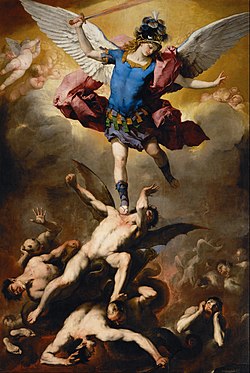 It was during writing of the Mafia book that Brown alleges began an intense series of supernatural experiences, ones he attributes to actual demonic forces around criminals and others he was working with, along with his own Upper East Side lifestyle as a bachelor. The experience, in September of 1983, involved a three-part dream with what he took to be angels healing him, one claiming to be the Archangel Michael [34]. The event, perhaps best described as a metanoia, may have occurred on September 29. This experience and others brought him back to church (though raised Catholic, he had not been a churchgoer for at least fifteen years). So unnerving was the dream (in which the face of a bearded devil appeared on his apartment door, before it was erased by the angel) that he immediately began attending daily Mass at Our Lady of Good Counsel Church on East 90th Street, half a block from his apartment at the Whitney House. Soon he also attended Sunday night services and Bible study at a non-denominational church,
It was during writing of the Mafia book that Brown alleges began an intense series of supernatural experiences, ones he attributes to actual demonic forces around criminals and others he was working with, along with his own Upper East Side lifestyle as a bachelor. The experience, in September of 1983, involved a three-part dream with what he took to be angels healing him, one claiming to be the Archangel Michael [34]. The event, perhaps best described as a metanoia, may have occurred on September 29. This experience and others brought him back to church (though raised Catholic, he had not been a churchgoer for at least fifteen years). So unnerving was the dream (in which the face of a bearded devil appeared on his apartment door, before it was erased by the angel) that he immediately began attending daily Mass at Our Lady of Good Counsel Church on East 90th Street, half a block from his apartment at the Whitney House. Soon he also attended Sunday night services and Bible study at a non-denominational church, 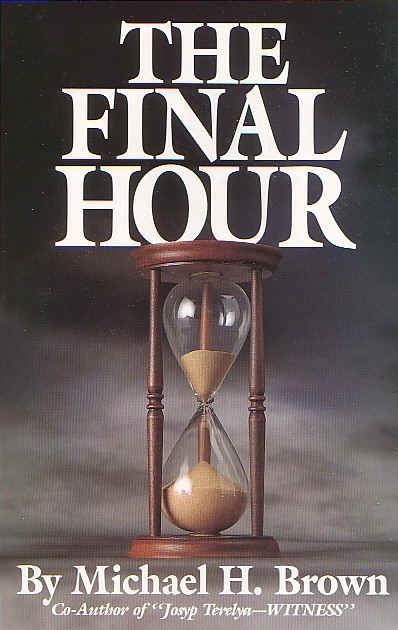 One Accord, in lower Manhattan, where he learned much about spiritual warfare. He found himself increasingly alienated by secular media that once embraced him, and felt no more affinity for worldly reportage, greatly concerned about atheism and religious antagonism in the media, as well as extreme liberalism. His own spiritual experiences went back to childhood, when he had several out-of-body-type experiences, perhaps as the result of near-death brushes during his severe childhood asthmatic attacks. He credited spiritual intuition with giving him the idea to conduct the first Love Canal health survey. He “heard” a voice telling him to look for breast cancer at the homes and that spurred him to take an informal, anecdotal health poll. During his “reversion,” he saw a light out the window of his Manhattan apartment that seemed to move about, across apartment buildings with a silhouette of the Blessed Mother in it. He also traveled to Medjugorje in former Yugoslavia, where he saw phenomena he could not dismiss (though initially skeptical) and has often recounted how a dream and the voice of what he took to be an angel saved him from a very dangerous fire in 1989 after moving back to Niagara Falls. A daily Mass communicant for now nearly forty years, at Medjugorje, among numerous phenomena, he witnessed a star that split into three smaller stars of three colors (blue, red, and white). This was observed by fifteen others, including with binoculars. He also saw the “miracle of the sun” numerous times, including a perfect Cross
One Accord, in lower Manhattan, where he learned much about spiritual warfare. He found himself increasingly alienated by secular media that once embraced him, and felt no more affinity for worldly reportage, greatly concerned about atheism and religious antagonism in the media, as well as extreme liberalism. His own spiritual experiences went back to childhood, when he had several out-of-body-type experiences, perhaps as the result of near-death brushes during his severe childhood asthmatic attacks. He credited spiritual intuition with giving him the idea to conduct the first Love Canal health survey. He “heard” a voice telling him to look for breast cancer at the homes and that spurred him to take an informal, anecdotal health poll. During his “reversion,” he saw a light out the window of his Manhattan apartment that seemed to move about, across apartment buildings with a silhouette of the Blessed Mother in it. He also traveled to Medjugorje in former Yugoslavia, where he saw phenomena he could not dismiss (though initially skeptical) and has often recounted how a dream and the voice of what he took to be an angel saved him from a very dangerous fire in 1989 after moving back to Niagara Falls. A daily Mass communicant for now nearly forty years, at Medjugorje, among numerous phenomena, he witnessed a star that split into three smaller stars of three colors (blue, red, and white). This was observed by fifteen others, including with binoculars. He also saw the “miracle of the sun” numerous times, including a perfect Cross 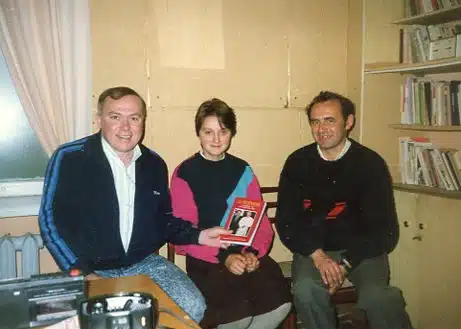 that formed over a vineyard and touched the earth; and moving stars on Apparition Hill. He met Don Shula and his wife on a vineyard during the first sun miracle he saw in 1990. He recalled how while seeing Vicka the first time with many pilgrims, she kept peering back at him (he was in the far rear) and he felt “called” to something — what, he could not know at the time. He ended up returning to Medjugorje to ask Mary what book he could do for her in return for the first incredible Medjugorje trip — a book on a Ukrainian martyr, or on the various apparitions — and he got the words, “yes, yes” — both books. One became the bio of the persecuted Ukrainian Catholic, the second, on apparitions since 1830, The Final Hour. He did not want to call it that title, but while writing the book before Mass one weekday in Niagara Falls, at the home of his parents, heard, “You shall call this book ‘The Final Hour.’ He rejected this twice but heard the same words three times — and that day at 8 a.m. Mass, the reading was from 1 John (“Children, it is the final hour”). A daily Bible reader, Brown, who most identifies with Saint John Paul II, whose canonization he attended, left the secular world of writing entirely at the end of 1990 to co-author Witness [35], with Josyp Terelya, the
that formed over a vineyard and touched the earth; and moving stars on Apparition Hill. He met Don Shula and his wife on a vineyard during the first sun miracle he saw in 1990. He recalled how while seeing Vicka the first time with many pilgrims, she kept peering back at him (he was in the far rear) and he felt “called” to something — what, he could not know at the time. He ended up returning to Medjugorje to ask Mary what book he could do for her in return for the first incredible Medjugorje trip — a book on a Ukrainian martyr, or on the various apparitions — and he got the words, “yes, yes” — both books. One became the bio of the persecuted Ukrainian Catholic, the second, on apparitions since 1830, The Final Hour. He did not want to call it that title, but while writing the book before Mass one weekday in Niagara Falls, at the home of his parents, heard, “You shall call this book ‘The Final Hour.’ He rejected this twice but heard the same words three times — and that day at 8 a.m. Mass, the reading was from 1 John (“Children, it is the final hour”). A daily Bible reader, Brown, who most identifies with Saint John Paul II, whose canonization he attended, left the secular world of writing entirely at the end of 1990 to co-author Witness [35], with Josyp Terelya, the 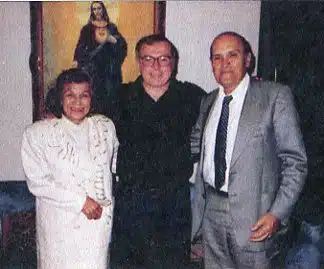 Ukrainian mystic who had been incarcerated for twenty years in the Soviet gulag for his faith. The book was later presented to John Paul II, who met several times with Terelya. Before setting out on that book, while traveling to Chicago for a college lecture, he entered a hotel suite and heard the word, “This will be your final college lecture.” Although he had done about a hundred, and the lectures were steady, with weekly communication with his lecture agent, that was the final one and his agent inexplicably never called again, and Michael Brown never felt inclined to ask why. In 1991 he broke ties to secular publishing, pursuing Catholic writing full time. His first religious publisher was Faith Publishing in Ohio. The week after the hotel incident he began the book with Terelya. That was followed by The Final Hour[36], which sold 200,000 copies with no publicity or advertising, although it was later
Ukrainian mystic who had been incarcerated for twenty years in the Soviet gulag for his faith. The book was later presented to John Paul II, who met several times with Terelya. Before setting out on that book, while traveling to Chicago for a college lecture, he entered a hotel suite and heard the word, “This will be your final college lecture.” Although he had done about a hundred, and the lectures were steady, with weekly communication with his lecture agent, that was the final one and his agent inexplicably never called again, and Michael Brown never felt inclined to ask why. In 1991 he broke ties to secular publishing, pursuing Catholic writing full time. His first religious publisher was Faith Publishing in Ohio. The week after the hotel incident he began the book with Terelya. That was followed by The Final Hour[36], which sold 200,000 copies with no publicity or advertising, although it was later  featured on Joan Rivers, Sally Jessey Raphael, Mother Angelica, TBN, and “Ancient Prophecies.” While researching the book, he saw a sun miracle at Betania in Venezuela that formed a perfect image of Mary as described at the Miraculous
featured on Joan Rivers, Sally Jessey Raphael, Mother Angelica, TBN, and “Ancient Prophecies.” While researching the book, he saw a sun miracle at Betania in Venezuela that formed a perfect image of Mary as described at the Miraculous 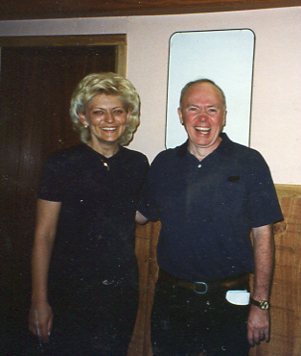 Medal. She was formed in rays that as at Medjugorje, reached from the sun. At Lourdes he saw clouds form the scene at Calvary and had many experiences at other shrines and apparition sites. He also traveled deep into Ukraine to study apparition sites shortly after the fall of Communism and throughout Europe, along with locales in Africa and South America. “When you see it and feel it for yourself — and when it’s transformational — it’s pretty much all you need as a journalist or anyone else,” he says. He also has had intense encounters with dark forces. The Final Hour was followed by many books on the afterlife, spiritual warfare, devotion, healing, prophecy, and other spiritual topics. He also penned a supernatural Christian novel, The Seven. He has visited more than thirty alleged apparition sites in various parts of theworld and has written thousands of Catholic-themed articles for his website, Spirit Daily. He has witnessed many other mystical events first-hand and believes his penchant for the mystical may derive from near-death brushes as a youngster from severe asthma. He also presents webinars. A pro-life advocate, he participated in 1991 in major protests at a late-term abortion clinic and doctor’s house in Buffalo. Before establishing the website, Spirit Daily, Brown spoke in
Medal. She was formed in rays that as at Medjugorje, reached from the sun. At Lourdes he saw clouds form the scene at Calvary and had many experiences at other shrines and apparition sites. He also traveled deep into Ukraine to study apparition sites shortly after the fall of Communism and throughout Europe, along with locales in Africa and South America. “When you see it and feel it for yourself — and when it’s transformational — it’s pretty much all you need as a journalist or anyone else,” he says. He also has had intense encounters with dark forces. The Final Hour was followed by many books on the afterlife, spiritual warfare, devotion, healing, prophecy, and other spiritual topics. He also penned a supernatural Christian novel, The Seven. He has visited more than thirty alleged apparition sites in various parts of theworld and has written thousands of Catholic-themed articles for his website, Spirit Daily. He has witnessed many other mystical events first-hand and believes his penchant for the mystical may derive from near-death brushes as a youngster from severe asthma. He also presents webinars. A pro-life advocate, he participated in 1991 in major protests at a late-term abortion clinic and doctor’s house in Buffalo. Before establishing the website, Spirit Daily, Brown spoke in  many dozens of churches across America and at many conferences and appeared several times on shows such as Mother Angelica Live (EWTN) and Paul and Jan Crouch (Trinity Broadcasting Network). He also has given retreats about the Blessed Mother and the mystical aspects of the Church in about 100 cities. In 2000 (on the very day the third secret of Fatima was announced for release), after another spiritual experience, Michael Brown and wife Lisa began operation of a major Christian-Catholic news/commentary/and aggregate website, Spirit Daily, which became their full-time job. That remains the case to this day, along with writing books and giving retreats. He served as a member of his bishop’s Council on Culture. He was a close friend of famed Maria Esperanza and her husband Geo of Venezuela. He believes his spiritual books to be his best and most important.
many dozens of churches across America and at many conferences and appeared several times on shows such as Mother Angelica Live (EWTN) and Paul and Jan Crouch (Trinity Broadcasting Network). He also has given retreats about the Blessed Mother and the mystical aspects of the Church in about 100 cities. In 2000 (on the very day the third secret of Fatima was announced for release), after another spiritual experience, Michael Brown and wife Lisa began operation of a major Christian-Catholic news/commentary/and aggregate website, Spirit Daily, which became their full-time job. That remains the case to this day, along with writing books and giving retreats. He served as a member of his bishop’s Council on Culture. He was a close friend of famed Maria Esperanza and her husband Geo of Venezuela. He believes his spiritual books to be his best and most important.+
PERSONAL LIFE
+
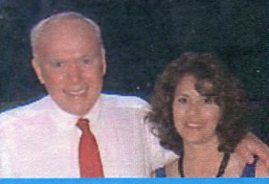 On October 30, 1993, Brown, at age 41, married Lisa Bassani, 33, at St. Thomas Roman Catholic Church in the Albany area, where she was employed as a legislative assistant and researcher for New York State Senator Roy Goodman of Manhattan. They have three children, Elizabeth, Joseph, and Mary Rose. He, wife Lisa, and Mary Rose now live near St. Augustine, Florida, their two other children in Orlando and New York City. Lisa and Michael met when Lisa read The Final Hour. Somehow — still not known — someone at his publisher gave her his personal number. After the call, Lisa heard a voice say “Matthew 19:6″ (“Therefore what God has joined together, let no one separate.”) Before Lisa knew she was pregnant, Michael heard a voice say she was “with child,” and he asked her if she was. There have been many mystical events.
On October 30, 1993, Brown, at age 41, married Lisa Bassani, 33, at St. Thomas Roman Catholic Church in the Albany area, where she was employed as a legislative assistant and researcher for New York State Senator Roy Goodman of Manhattan. They have three children, Elizabeth, Joseph, and Mary Rose. He, wife Lisa, and Mary Rose now live near St. Augustine, Florida, their two other children in Orlando and New York City. Lisa and Michael met when Lisa read The Final Hour. Somehow — still not known — someone at his publisher gave her his personal number. After the call, Lisa heard a voice say “Matthew 19:6″ (“Therefore what God has joined together, let no one separate.”) Before Lisa knew she was pregnant, Michael heard a voice say she was “with child,” and he asked her if she was. There have been many mystical events.+
PUBLICATIONS:
+
PK: A Report on Psychokinesis (Steinberbooks, 1977)
Laying Waste: The Poisoning of America By Toxic Chemicals (Pantheon, 1979)
Marked To Die (Simon & Schuster, 1984)
The Toxic Cloud (HarperCollins, 1989)
The Greenpeace Story (Dorling Kindersley, 1989)
The Search For Eve (HarperCollins, 1990)
Witness (Faith Publishing, 1991)
The Final Hour (Faith Publishing, 1992)
Prayer of the Warrior (Faith Publishing, 1993)
The Bridge To Heaven (Marian Communications, 1993)
The Trumpet of Gabriel (Faith Publishing, 1994)
Secrets of the Eucharist (Faith Publishing, 1996)
The Day Will Come (Servant Publication, 1996)
After Life (Faith Publishing, 1997)
The Last Secret (Servant Publication, 1998)
Seven Days With Mary (Faith Publication, 1998)
Sent To Earth (Queenship, 2000)
The Best of Spirit Daily (Queenship, 2002)
The God of Miracles (Queenship, 2005)
Tower of Light (Spirit Daily Publishing, 2007)
The Other Side (Spirit Daily Publishing, 2008)
The Seven (Spirit Daily Publishing, 2009)
The Spirits Around Us (Spirit Daily Publishing, 2010)
A Life of Blessings (Spirit Daily Publishing, 2012)
Fear of Fire (Spirit Daily Publishing, 2013)
What You Take To Heaven (Spirit Daily Publishing, 2014)
The God of Healing (Spirit Daily Publishing, 2015)
Where the Cross Stands (Spirit Daily Publishing, 2017)
Lying Wonders, Strangest Things(Spirit Daily Publishing, 2019)
The New York Prophecy (upcoming)
+
FOOTNOTES:
1. The Best of People: The First Decade, Ballantine Books, 1984
2. He Turns Tables On Physics, Binghamton Sun-Bulletin, April 7, 1975
3. Laying Waste: The Poisoning of America By Toxic Chemicals (Pantheon, 1979)
4. “Red Tape Stalls Dump Solution,” The Niagara Gazette, by Mike Brown, February 5, 1978
5. “Dump Neighbors Wondering,” The Niagara Gazette, by Mike Brown, June 25, 1978
6. “State To Study Love Canal Health ‘Ills,’” by Mike Brown, the Niagara Gazette, May 21, 1978
7. “Toxic Exposure at Love Canal Called Chronic,” by Mike Brown, May 25, 1978
8. Laying Waste: The Poisoning of America By Toxic Chemicals (Pantheon, 1979)
9. Laying Waste: The Poisoning of America By Toxic Chemicals (Pantheon, 1979)
10. “State To Study Love Canal Health ‘Ills,’” by Mike Brown, the Niagara Gazette, May 21, 1978
11. “Love Canal research hints at birth defects,” by Mike Brown, the Niagara Gazette, July 15, 1978
12. “Love Canal residents’ evacuation mulled,” by Mike Brown, the Niagara Gazette, May 20, 1978
13. “Upstate Waste Site May Endanger Lives,” by Donald G. McNeil, The New York Times, August 2, 1978
14. “Canal Chemicals Fan Out,” by Mike Brown, the Niagara Gazette, August 9, 1978
15. “State, private studies at odds on canal drain illness pockets,” by Mike Brown, the Niagara Gazette, October 4, 1978
16. “Worry over toxins extends to Buffalo Avenue residents,” by Mike Brown, the Niagara Gazette, August 18, 1978
17. “Chemicals surround Falls water plant,” by Mike Brown, the Niagara Gazette, October 5, 1978
18. “High PCB levels found in Gill Creek,” by Mike Brown, the Niagara Gazette, September 8, 1978
19. Laying Waste: The Poisoning of America By Toxic Chemicals (Pantheon, 1979)
20. “Love Canal, USA,” by Michael H. Brown, The New York Times Magazine, January 21, 1978
21. “Love Canal and What It Says About the Poisoning of America,” by Michael H. Brown, the Atlantic Monthly, December 1979
22. “New Jersey Cleans Up Its Pollution Act,” by Michael H. Brown, The New York Times Magazine, November 23, 1980
23. “Is Hemlock Being Slowly Poisoned?” by Michael H. Brown, The New York Times Magazine, July 15, 1979
24. “Stop the Poisoning of America,” by Michael H. Brown, Reader’s Digest, May 1979
25. Toxic Waste: Organized Crime Moves In, by Michael H. Brown, July 1984
24. “The Price of Life,” by Michael H. Brown, New York Magazine, March 10, 1980
25. “Those Killer Chemical Wastes Are Poisoning America,” Family Weekly, January 11, 1981
26. “Killer Towns: Special Report: What the government can’t say about death in America,” by Michael H. Brown, Rolling Stone, November 26, 1981
27. Marked To Die (Simon & Schuster, 1984)
28. The Toxic Cloud (HarperCollins, 1989)
29. “Getting Serious About the Occult,” by Michael H. Brown, The Atlantic Monthly, October 1978
30. “The National Swill: Poisoning the Mississippi,” by Michael H. Brown, Science Digest, June 1986
31. “Here’s the Beef: Fast Foods Are Hazardous To Your Health,” by Michael H. Brown, Science Digest, April, 1986
32. “What’s the Beef?” editorial, The New York Times, April 4, 1986
33. The Search For Eve (HarperCollins, 1990)
34. Prayer of the Warrior (Faith Publishing, 1993)
35. Witness, Josyp Terelya with Michael H. Brown (Faith Publishing, 1991)
36. The Final Hour (Faith Publishing, 1992)
[see also:
Love Canal Revisited, Michael H. Brown, Amicus Journal, Summer 1988
He Told the Stories Behind the Fence, the Niagara Gazette, by Don Glynn, July 26, 1998
A Wasted National Resource: Millions of Barrels of Engine Oil, by Michael H. Brown, The New York Times, May 4, 1980
A Toxic Ghost Town, by Michael H. Brown, The Atlantic Monthly, July 1989
Contaminating the Countryside, by Kai Erikson, The New York Times Book Review, May 18, 1980
A Shocker, The New York Times, April 25, 1980, page C-24
State Health Formula Weighs Value of Life Against Project Costs, by Peter Kihss, The New York Times, March 3, 1989, B3
Toxic Wind: Coming Soon to the Air Near You, by Michael H. Brown, Discover Magazine, November 1987
Dumping the Responsibility for Toxic Sites, by Michael H. Brown, Newsday, May 28, 1980]
EXTERNAL LINKS:

